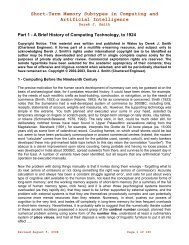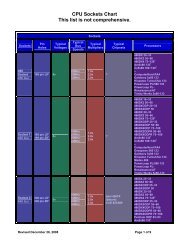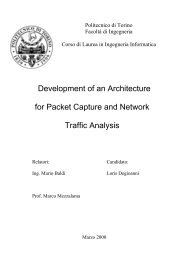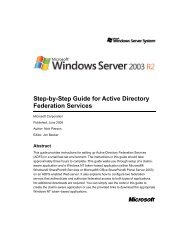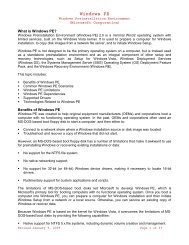A History of Viruses.pdf - Bandwidthco Computer Security
A History of Viruses.pdf - Bandwidthco Computer Security
A History of Viruses.pdf - Bandwidthco Computer Security
Create successful ePaper yourself
Turn your PDF publications into a flip-book with our unique Google optimized e-Paper software.
A <strong>History</strong> <strong>of</strong> <strong>Viruses</strong><br />
volume label with the name <strong>of</strong> the virus.<br />
Like Elk, Brain was pretty benign, as computer viruses go. It doesn't delete your files. It<br />
replicates and moves on. Again, being harmless is a good strategy for a virus - for biological<br />
ones as well as malware. Compare your chances <strong>of</strong> catching the common cold to, say,<br />
Hantavirus. The more damage the pathogen does, the more it gets noticed. With a little self-<br />
restraint, a virus like (c)Brain can survive in the wild for a long, long time. The volume label<br />
behavior has been changed in subsequent programmer-induced "mutations" <strong>of</strong> (c)Brain. Most<br />
likely, this is because it's too easy for an "infected" user to discover the presence <strong>of</strong> the virus<br />
merely by simply noticing the changed volume label.<br />
Other viruses soon followed (c)Brain. Among them were Alameda (Yale), Cascade, Jerusalem,<br />
Lehigh and Miami (South African Friday the 13th). These viruses exhibited some new tricks:<br />
while (c)Brain infected the boot sector, the new guys were able to infect .COM and .EXE files.<br />
As well as looking for new targets <strong>of</strong> infection, virus programmers were starting to hide their<br />
work. Cascade was the first encrypted virus - a technique meant to deter disassembly and<br />
detection <strong>of</strong> the virus' program code.<br />
Variable encryption made its debut in 1989 with the "1260" virus. This now meant that<br />
scanning for fixed strings common to all copies <strong>of</strong> a given virus would be less effective, as the<br />
majority <strong>of</strong> the virus' code appeared in a different form with each successive infection.<br />
The same year, the first stealth techniques emerged. These viruses could change or conceal<br />
their location in memory, actively avoiding detection and removal by anti-virus tools.<br />
The Whale virus took this even further - it could rewrite its own instructions in such a way that<br />
it never consistently looks the same way twice. This marked the beginning <strong>of</strong> the end for string<br />
scanning and other techniques which relied on fixed, predictable elements appearing in each<br />
copy <strong>of</strong> a virus. As it happens, Whale was not particularly talented - it has been described as<br />
"too clumsy to work". Even still, its size and new, complex behavior made it famous.<br />
Until this time, two classes <strong>of</strong> wild PC viruses had been reported. File infectors, which append<br />
themselves to executable programs, and boot sector viruses, which take advantage <strong>of</strong> the<br />
special segment <strong>of</strong> executable code at the beginning <strong>of</strong> a floppy or hard disk which is executed<br />
by the PC on startup.<br />
http://www.securityfocus.com/print/infocus/1286 (3 <strong>of</strong> 6) [7/27/2008 2:00:14 PM]





